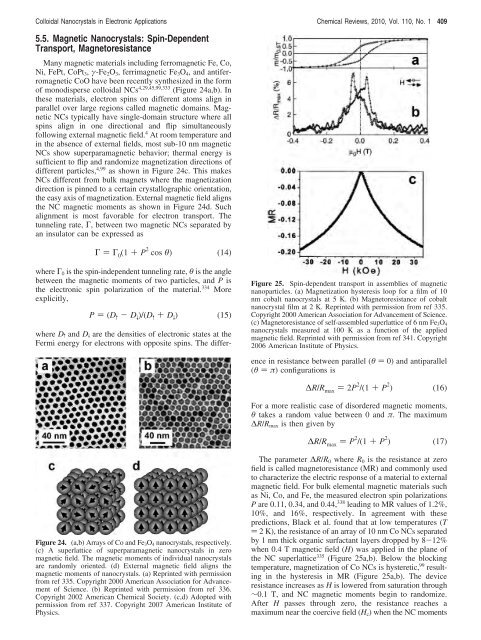Prospects of Colloidal Nanocrystals for Electronic - Computer Science
Prospects of Colloidal Nanocrystals for Electronic - Computer Science
Prospects of Colloidal Nanocrystals for Electronic - Computer Science
Create successful ePaper yourself
Turn your PDF publications into a flip-book with our unique Google optimized e-Paper software.
<strong>Colloidal</strong> <strong>Nanocrystals</strong> in <strong>Electronic</strong> Applications Chemical Reviews, 2010, Vol. 110, No. 1 409<br />
5.5. Magnetic <strong>Nanocrystals</strong>: Spin-Dependent<br />
Transport, Magnetoresistance<br />
Many magnetic materials including ferromagnetic Fe, Co,<br />
Ni, FePt, CoPt3, γ-Fe2O3, ferrimagnetic Fe3O4, and antiferromagnetic<br />
CoO have been recently synthesized in the <strong>for</strong>m<br />
<strong>of</strong> monodisperse colloidal NCs 4,29,45,99,333 (Figure 24a,b). In<br />
these materials, electron spins on different atoms align in<br />
parallel over large regions called magnetic domains. Magnetic<br />
NCs typically have single-domain structure where all<br />
spins align in one directional and flip simultaneously<br />
following external magnetic field. 4 At room temperature and<br />
in the absence <strong>of</strong> external fields, most sub-10 nm magnetic<br />
NCs show superparamagnetic behavior; thermal energy is<br />
sufficient to flip and randomize magnetization directions <strong>of</strong><br />
different particles, 4,99 as shown in Figure 24c. This makes<br />
NCs different from bulk magnets where the magnetization<br />
direction is pinned to a certain crystallographic orientation,<br />
the easy axis <strong>of</strong> magnetization. External magnetic field aligns<br />
the NC magnetic moments as shown in Figure 24d. Such<br />
alignment is most favorable <strong>for</strong> electron transport. The<br />
tunneling rate, Γ, between two magnetic NCs separated by<br />
an insulator can be expressed as<br />
Γ ) Γ 0 (1 + P 2 cos θ) (14)<br />
where Γ0 is the spin-independent tunneling rate, θ is the angle<br />
between the magnetic moments <strong>of</strong> two particles, and P is<br />
the electronic spin polarization <strong>of</strong> the material. 334 More<br />
explicitly,<br />
P ) (D v - D V )/(D v + D V ) (15)<br />
where Dv and DV are the densities <strong>of</strong> electronic states at the<br />
Fermi energy <strong>for</strong> electrons with opposite spins. The differ-<br />
Figure 24. (a,b) Arrays <strong>of</strong> Co and Fe3O4 nanocrystals, respectively.<br />
(c) A superlattice <strong>of</strong> superparamagnetic nanocrystals in zero<br />
magnetic field. The magnetic moments <strong>of</strong> individual nanocrystals<br />
are randomly oriented. (d) External magnetic field aligns the<br />
magnetic moments <strong>of</strong> nanocrystals. (a) Reprinted with permission<br />
from ref 335. Copyright 2000 American Association <strong>for</strong> Advancement<br />
<strong>of</strong> <strong>Science</strong>. (b) Reprinted with permission from ref 336.<br />
Copyright 2002 American Chemical Society. (c,d) Adopted with<br />
permission from ref 337. Copyright 2007 American Institute <strong>of</strong><br />
Physics.<br />
Figure 25. Spin-dependent transport in assemblies <strong>of</strong> magnetic<br />
nanoparticles. (a) Magnetization hysteresis loop <strong>for</strong> a film <strong>of</strong> 10<br />
nm cobalt nanocrystals at 5 K. (b) Magnetoresistance <strong>of</strong> cobalt<br />
nanocrystal film at 2 K. Reprinted with permission from ref 335.<br />
Copyright 2000 American Association <strong>for</strong> Advancement <strong>of</strong> <strong>Science</strong>.<br />
(c) Magnetoresistance <strong>of</strong> self-assembled superlattice <strong>of</strong> 6 nm Fe3O4<br />
nanocrystals measured at 100 K as a function <strong>of</strong> the applied<br />
magnetic field. Reprinted with permission from ref 341. Copyright<br />
2006 American Institute <strong>of</strong> Physics.<br />
ence in resistance between parallel (θ ) 0) and antiparallel<br />
(θ ) π) configurations is<br />
∆R/R max ) 2P 2 /(1 + P 2 ) (16)<br />
For a more realistic case <strong>of</strong> disordered magnetic moments,<br />
θ takes a random value between 0 and π. The maximum<br />
∆R/Rmax is then given by<br />
∆R/R max ) P 2 /(1 + P 2 ) (17)<br />
The parameter ∆R/R0 where R0 is the resistance at zero<br />
field is called magnetoresistance (MR) and commonly used<br />
to characterize the electric response <strong>of</strong> a material to external<br />
magnetic field. For bulk elemental magnetic materials such<br />
as Ni, Co, and Fe, the measured electron spin polarizations<br />
P are 0.11, 0.34, and 0.44, 338 leading to MR values <strong>of</strong> 1.2%,<br />
10%, and 16%, respectively. In agreement with these<br />
predictions, Black et al. found that at low temperatures (T<br />
) 2 K), the resistance <strong>of</strong> an array <strong>of</strong> 10 nm Co NCs separated<br />
by 1 nm thick organic surfactant layers dropped by 8-12%<br />
when 0.4 T magnetic field (H) was applied in the plane <strong>of</strong><br />
the NC superlattice 335 (Figure 25a,b). Below the blocking<br />
temperature, magnetization <strong>of</strong> Co NCs is hysteretic, 99 resulting<br />
in the hysteresis in MR (Figure 25a,b). The device<br />
resistance increases as H is lowered from saturation through<br />
∼0.1 T, and NC magnetic moments begin to randomize.<br />
After H passes through zero, the resistance reaches a<br />
maximum near the coercive field (Hc) when the NC moments
















